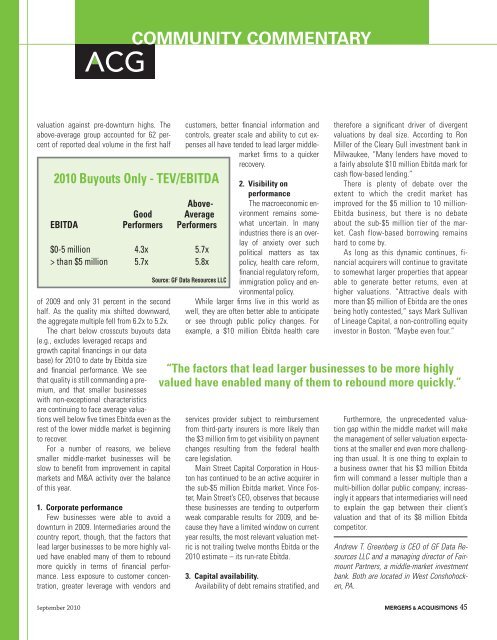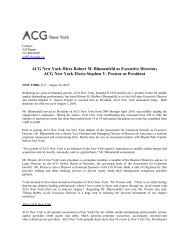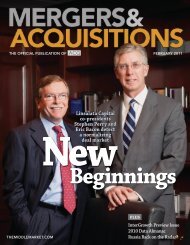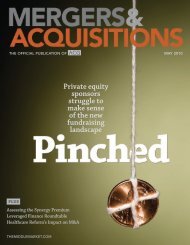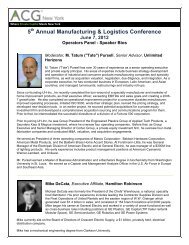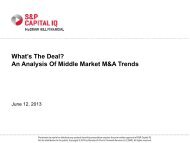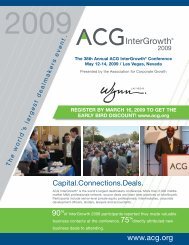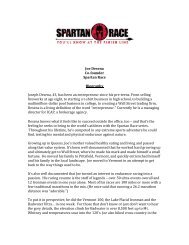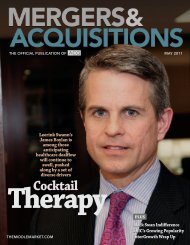September 2010 - Association for Corporate Growth
September 2010 - Association for Corporate Growth
September 2010 - Association for Corporate Growth
You also want an ePaper? Increase the reach of your titles
YUMPU automatically turns print PDFs into web optimized ePapers that Google loves.
COMMUNITY COMMENTARY<br />
valuation against pre-downturn highs. The<br />
above-average group accounted <strong>for</strong> 62 percent<br />
of reported deal volume in the first half<br />
<strong>2010</strong> Buyouts Only - TEV/EBITDA<br />
Above-<br />
Good Average<br />
EBITDA Per<strong>for</strong>mers Per<strong>for</strong>mers<br />
$0-5 million 4.3x 5.7x<br />
> than $5 million 5.7x 5.8x<br />
of 2009 and only 31 percent in the second<br />
half. As the quality mix shifted downward,<br />
the aggregate multiple fell from 6.2x to 5.2x.<br />
The chart below crosscuts buyouts data<br />
(e.g., excludes leveraged recaps and<br />
growth capital financings in our data<br />
base) <strong>for</strong> <strong>2010</strong> to date by Ebitda size<br />
and financial per<strong>for</strong>mance. We see<br />
that quality is still commanding a premium,<br />
and that smaller businesses<br />
with non-exceptional characteristics<br />
are continuing to face average valuations<br />
well below five times Ebitda even as the<br />
rest of the lower middle market is beginning<br />
to recover.<br />
For a number of reasons, we believe<br />
smaller middle-market businesses will be<br />
slow to benefit from improvement in capital<br />
markets and M&A activity over the balance<br />
of this year.<br />
1. <strong>Corporate</strong> per<strong>for</strong>mance<br />
Few businesses were able to avoid a<br />
downturn in 2009. Intermediaries around the<br />
country report, though, that the factors that<br />
lead larger businesses to be more highly valued<br />
have enabled many of them to rebound<br />
more quickly in terms of financial per<strong>for</strong>mance.<br />
Less exposure to customer concentration,<br />
greater leverage with vendors and<br />
customers, better financial in<strong>for</strong>mation and<br />
controls, greater scale and ability to cut expenses<br />
all have tended to lead larger middlemarket<br />
firms to a quicker<br />
recovery.<br />
Source: GF Data Resources LLC<br />
2. Visibility on<br />
per<strong>for</strong>mance<br />
The macroeconomic environment<br />
remains somewhat<br />
uncertain. In many<br />
industries there is an overlay<br />
of anxiety over such<br />
political matters as tax<br />
policy, health care re<strong>for</strong>m,<br />
financial regulatory re<strong>for</strong>m,<br />
immigration policy and environmental<br />
policy.<br />
While larger firms live in this world as<br />
well, they are often better able to anticipate<br />
or see through public policy changes. For<br />
example, a $10 million Ebitda health care<br />
services provider subject to reimbursement<br />
from third-party insurers is more likely than<br />
the $3 million firm to get visibility on payment<br />
changes resulting from the federal health<br />
care legislation.<br />
Main Street Capital Corporation in Houston<br />
has continued to be an active acquirer in<br />
the sub-$5 million Ebitda market. Vince Foster,<br />
Main Street’s CEO, observes that because<br />
these businesses are tending to outper<strong>for</strong>m<br />
weak comparable results <strong>for</strong> 2009, and because<br />
they have a limited window on current<br />
year results, the most relevant valuation metric<br />
is not trailing twelve months Ebitda or the<br />
<strong>2010</strong> estimate – its run-rate Ebitda.<br />
3. Capital availability.<br />
Availability of debt remains stratified, and<br />
there<strong>for</strong>e a significant driver of divergent<br />
valuations by deal size. According to Ron<br />
Miller of the Cleary Gull investment bank in<br />
Milwaukee, “Many lenders have moved to<br />
a fairly absolute $10 million Ebitda mark <strong>for</strong><br />
cash flow-based lending.”<br />
There is plenty of debate over the<br />
extent to which the credit market has<br />
improved <strong>for</strong> the $5 million to 10 million-<br />
Ebitda business, but there is no debate<br />
about the sub-$5 million tier of the market.<br />
Cash flow-based borrowing remains<br />
hard to come by.<br />
As long as this dynamic continues, financial<br />
acquirers will continue to gravitate<br />
to somewhat larger properties that appear<br />
able to generate better returns, even at<br />
higher valuations. “Attractive deals with<br />
more than $5 million of Ebitda are the ones<br />
being hotly contested,” says Mark Sullivan<br />
of Lineage Capital, a non-controlling equity<br />
investor in Boston. “Maybe even four.”<br />
“The factors that lead larger businesses to be more highly<br />
valued have enabled many of them to rebound more quickly.”<br />
Furthermore, the unprecedented valuation<br />
gap within the middle market will make<br />
the management of seller valuation expectations<br />
at the smaller end even more challenging<br />
than usual. It is one thing to explain to<br />
a business owner that his $3 million Ebitda<br />
firm will command a lesser multiple than a<br />
multi-billion dollar public company; increasingly<br />
it appears that intermediaries will need<br />
to explain the gap between their client’s<br />
valuation and that of its $8 million Ebitda<br />
competitor.<br />
Andrew T. Greenberg is CEO of GF Data Resources<br />
LLC and a managing director of Fairmount<br />
Partners, a middle-market investment<br />
bank. Both are located in West Conshohocken,<br />
PA.<br />
<strong>September</strong> <strong>2010</strong> MERGERS & ACQUISITIONS 45


